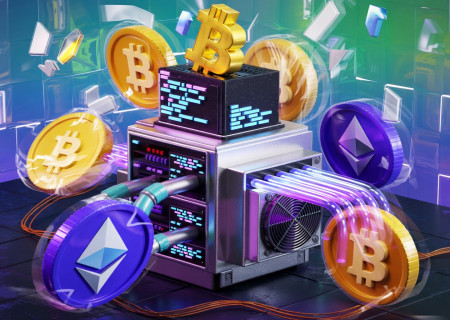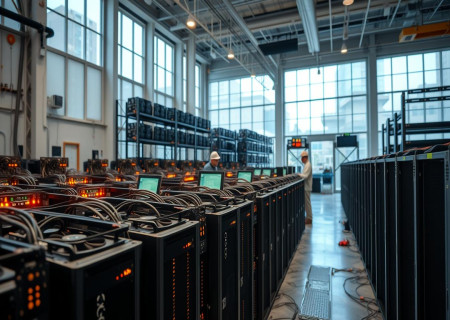
- April 13, 2025
- 8 months ago
How to Choose the Best Bitcoin Mining Pool – 2025 Comparison
The scene of cryptocurrencies is continually shifting. For pros as well as enthusiasts, mining profitability is rather important.
Making more money requires a proper mining pool. One must make wise decisions.
The realm of cryptocurrencies mining will be considerably more cutthroat in 2025. Many mining pools will present distinct benefits and difficulties.
This page will guide you in determining the features of a bitcoin mining pool of interest. We will ensure your mining activities maximise their benefits.
What You Need to Know About Bitcoin Mining in 2025
The scene of Bitcoin mining is fast evolving as we head into 2025. The mining game is growing more difficult. Miners have to follow fresh ideas and challenges.
Current State of Bitcoin Mining
Modern technologies and large mining gear investments define the Bitcoin mining scenario of today. Miners constantly seek for strategies to improve their performance. They want to find the challenging arithmetic required to validate transactions and mine fresh Bitcoins.
The Role of Mining Pools in Today's Ecosystem
Key in the Bitcoin universe are mining pools. They let miners team to maximise their output. "The future of Bitcoin mining is in miners working together and adapting to new circumstances," a leading expert argues.
Joining a mining pool guarantees miners a consistent pay. Maintaining their businesses running strong depends on this.
Understanding Bitcoin Mining Pools
Key in the realm of cryptocurrencies are bitcoin mining pools. They enable miners to cooperate in order to tackle difficult arithmetic challenges.
A Bitcoin mining pool is assembly of miners. To solve blocks and gain prizes, they share their computing power.
What Is a Bitcoin Mining Pool?
A Bitcoin mining pool is a team effort. Miners share their resources.
This way, they can distribute the workload and share the rewards. It's good for miners with less power.
How Mining Pools Work
Mining pools combine the power of all miners.
Together, they solve complex math problems. The rewards are split among the pool members based on their share.
Why Join a Mining Pool Instead of Solo Mining
Joining a mining pool has many benefits. You get more predictable income and reduced variance in earnings.
By working together, miners get a steady income. Solo mining rewards come and go.
Key Factors to Consider When Choosing a Bitcoin Mining Pool
Choosing a Bitcoin mining pool is key to your mining success and profits. There are important factors to think about to make a good choice.
Pool Fees and Payout Structure
Mining pools take fees that can change your earnings. Pool fees usually range from 0% to 4%. It's also important to know the payout structure. This tells you how often and how much you get paid.
Pool Size and Hash Rate
The size of a mining pool, shown by its hash rate, affects how often you get paid. Bigger pools pay more often but might charge higher fees.
| Pool Characteristics | Small Pool | Large Pool |
| Hash Rate | Lower | Higher |
| Payout Frequency | Less Frequent | More Frequent |
| Fees | Variable | Competitive |
Reliability and Uptime
Geographic Location and Latency
The geographic location of a pool can impact latency. This affects your mining efficiency.
Security Measures
Strong security measures are vital. They protect against attacks and keep the pool safe.
Popular Payout Methods Explained
Bitcoin mining pools use different payout methods. Each has its own good and bad points. It's key for miners to know these to choose the right pool.
Pay-Per-Share (PPS)
The Pay-Per-Share (PPS) method gives miners a set amount for each share they help mine. It doesn't matter if the pool finds a block or not. This way, miners know what they'll get but might pay more fees.
Proportional (PROP)
With the Proportional (PROP) method, miners get paid based on how many shares they had when a block is found. It's fair and clear but earnings can change a lot.
Pay-Per-Last-N-Shares (PPLNS)
The Pay-Per-Last-N-Shares (PPLNS) method pays miners for their shares over a time. It keeps miners coming back and can give more money to those who stay.
Other Payment Methods
Other ways to pay include Pay-Per-Share-Plus (PPS+) and Score-based methods. PPS+ mixes PPS and PPLNS. Score-based pays based on how much hash rate a miner adds to the pool.
Here's a quick look at the payout methods:
| Payout Method | Key Features | Advantages | Disadvantages |
| PPS | Fixed payout per share | Predictable earnings | Higher fees |
| PROP | Payout based on proportion of shares | Fair and transparent | Variable earnings |
| PPLNS | Payout based on last N shares | Encourages loyalty, potentially higher earnings | Complex payout structure |
Top Bitcoin Mining Pools in 2025 Comparison
In 2025, the top Bitcoin mining pools are key for miners to get the most from their work. The world of cryptocurrency mining keeps changing. Picking the right pool can really help a miner's earnings.
Antpool
Antpool is a big name in Bitcoin mining pools. It has a strong platform with good fees.
Features and Benefits
- Reliable and Stable Operation: Antpool is known for its high uptime and stable operation, ensuring minimal disruption to mining activities.
- Advanced Mining Technology: The pool utilizes advanced technology to optimize mining efficiency.
Fee Structure
Antpool charges a competitive fee of 2% for its services, making it an attractive option for miners looking to minimize costs.
F2Pool
F2Pool is another big name in Bitcoin mining pools. It's known for its easy-to-use interface and lots of features.
Features and Benefits
- User-Friendly Interface: F2Pool offers an intuitive interface that makes it easy for miners to navigate and manage their activities.
- Detailed Statistics: The pool provides detailed statistics and insights, helping miners optimize their operations.
Fee Structure
F2Pool operates on a 2.5% fee structure. This is a bit higher than some, but the pool's strong features and reliability make it worth it.
Foundry USA
Foundry USA is a big player in Bitcoin mining pools, mainly for large mining operations.
Features and Benefits
- High-Performance Infrastructure: Foundry USA boasts high-performance infrastructure designed to support large-scale mining.
- Competitive Fees: The pool offers competitive pricing, making it attractive to large miners.
Fee Structure
Foundry USA charges a fee of 2%. This is in line with the industry standard and offers top-notch service.
Binance Pool
Binance Pool is backed by Binance, a big name in cryptocurrency. It offers a solid mining pool solution.
Features and Benefits
- Integration with Binance Exchange: The pool's integration with the Binance exchange provides seamless transitions between mining and trading.
- Competitive Pricing: Binance Pool offers competitive fees, appealing to miners who are also users of the Binance platform.
Fee Structure
Binance Pool charges a 2.5% fee. This is in line with other major pools, balancing cost and service quality.
Other Notable Pools
Other notable Bitcoin mining pools include ViaBTC, Poolin, and Bitminter. Each has unique features and competitive fees.
How to Evaluate a Bitcoin Mining Pool's Profitability
It's key for miners to check a Bitcoin mining pool's profit to boost their earnings.
To figure out a pool's profit, you need to look at a few things. Calculating expected returns is a big step. It shows how much a miner could make from a pool.
Calculating Expected Returns
Expected returns depend on the pool's fees, the miner's hash rate, and the Bitcoin price. Lower fees and higher hash rates mean more money.
Using Mining Calculators
Mining calculators help guess how much you could earn. They look at the pool's fees and your mining gear.
Comparing Historical Performance
| Pool Name | Fee Structure | Average Monthly Earnings |
| Antpool | 0% | $1,500 |
| F2Pool | 2% | $1,200 |
| Foundry USA | 0.5% | $1,800 |
By looking at these points and using the right tools, miners can choose the best pool.
Step-by-Step Guide to Joining a Bitcoin Mining Pool
Joining a Bitcoin mining pool is key for miners to get steady rewards. The process involves several key steps that miners must follow to successfully integrate into a pool.
Setting Up Your Mining Hardware
Before joining a pool, make sure your mining hardware is set up right. This means configuring your ASIC miners or other mining equipment.
Creating a Wallet for Payouts
Create a Bitcoin wallet to get your mining rewards. Make sure the wallet works with the pool's payout system.
Configuring Your Mining Software
Choose a mining software that fits your hardware and the mining pool. Set it up as the pool says.
Connecting to Your Chosen Pool
With your hardware and software ready, connect to the mining pool. Just enter the pool's server details into your mining software.
Monitoring Your Mining Performance
After connecting, monitor your mining performance on the pool's dashboard. This lets you spot problems and improve your mining.
Regulatory Considerations for US-Based Miners
Understanding the regulatory framework is key for US-based Bitcoin miners.
Current Legal Framework
The legal landscape for Bitcoin mining in the US is complex. It's influenced by both federal and state laws. Miners must follow rules about energy use and financial dealings.
Tax Implications
Bitcoin mining is seen as taxable. Miners need to declare their earnings and costs on tax forms.
Compliance Requirements
US-based miners must adhere to Anti-Money Laundering (AML) and Know Your Customer (KYC) rules.
| Regulation | Description | Impact on Miners |
| AML/KYC | Anti-Money Laundering and Know Your Customer regulations | Miners must verify customer identities and report suspicious activities |
| Tax Laws | Laws governing the taxation of cryptocurrency mining | Miners must report income and expenses on tax returns |
Environmental Impact and Sustainability
The world is now more aware of environmental issues. Bitcoin mining's impact on the environment is being closely watched. Mining Bitcoins uses a lot of energy, leading to a lot of carbon emissions.
Energy Consumption Concerns
Bitcoin mining uses a lot of electricity. This electricity is often made from non-renewable sources. This leads to a lot of greenhouse gas emissions. Key concerns include:
- High energy consumption
- Dependence on non-renewable energy sources
- Environmental impact of mining hardware
Green Mining Initiatives
Several green mining initiatives have been started. These include:
- Using renewable energy sources like solar or hydroelectric power
- Improving the energy efficiency of mining hardware
- Implementing sustainable mining practices
Pools with Sustainability Focus
Some mining pools are focusing on sustainability. For example:
- Pools using renewable energy for mining operations
- Pools implementing energy-efficient mining protocols
These efforts aim to lessen Bitcoin mining's environmental impact.
Advanced Strategies for Maximizing Mining Pool Profits
Experienced miners use advanced strategies to boost mining pool profits. To stay competitive in Bitcoin mining, they need to use complex techniques. These techniques help optimize their mining operations.
Pool Hopping: Pros and Cons
Pool hopping means switching mining pools to get better profits. This strategy can be very profitable if done right. It lets miners take advantage of different pool fees and rewards. But, it can also destabilize pool operations and lead to penalties or lower earnings.
Multi-Pool Mining
Multi-pool mining involves joining multiple mining pools at once. This strategy can spread out mining risks and boost profits. It uses the strengths of different pools to increase earnings.
Optimizing Mining Settings
Optimizing mining settings is key to making more money. This includes tweaking hardware and
By using these advanced strategies, miners can greatly improve their earnings. They stay ahead in the changing world of Bitcoin mining.
Conclusion
Choosing the right Bitcoin mining pool is key to making money in the competitive world of cryptocurrency mining. This article compared the top Bitcoin mining pools in 2025. It looked at important factors like pool fees, how payouts work, and security.
The Bitcoin mining world is always changing. Miners need to keep up with new trends and developments. By knowing the good and bad of different pools, miners can make better choices and improve their mining.
Doing a deep dive into bitcoin mining pool comparisons is vital for finding the most profitable and reliable ones. Whether you're experienced or new, picking the right pool can greatly affect your earnings. As the crypto market expands, picking a trustworthy and efficient mining pool will become even more critical.
FAQ
What is a Bitcoin mining pool?
A Bitcoin mining pool is a group of miners working together. They use their computing power to solve complex problems. This helps validate transactions on the Bitcoin network and earns them rewards.
How do I choose the best Bitcoin mining pool for my needs?
To pick the best pool, look at pool fees and how rewards are paid out. Also, consider the pool's size, hash rate, reliability, and security. Don't forget about uptime and where the pool is located.
What are the different payout methods used by Bitcoin mining pools?
Bitcoin mining pools use Pay-Per-Share (PPS), Proportional (PROP), and Pay-Per-Last-N-Shares (PPLNS). Each method has its own advantages and disadvantages.
How do I evaluate the profitability of a Bitcoin mining pool?
To check a pool's profitability, use mining calculators. Look at the pool's past performance and expected returns. Consider fees and hash rate too.
What are some of the top Bitcoin mining pools in 2025?
In 2025, top pools include Antpool, F2Pool, Foundry USA, and Binance Pool. Each has its own benefits and fee structures.
What are the regulatory considerations for US-based Bitcoin miners?
US miners need to know the current laws, taxes, and compliance rules for mining Bitcoin.
How can I minimize the environmental impact of my Bitcoin mining activities?
To reduce environmental harm, use green mining methods. Choose pools focused on sustainability. Lowering energy use also helps.
What are some advanced strategies for maximizing mining pool profits?
For better profits, try pool hopping and multi-pool mining. Also, tweak your mining settings to boost efficiency.




